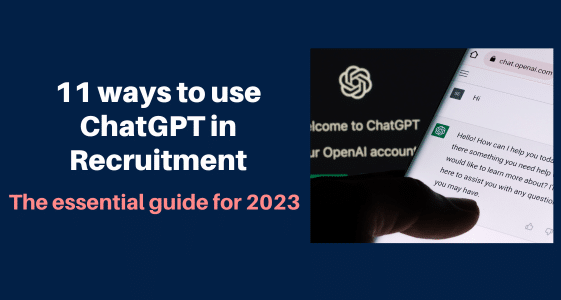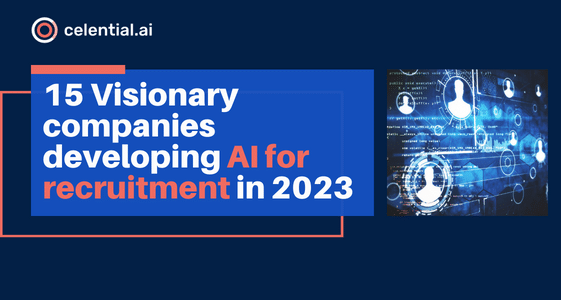With the number of open roles far outpacing the number of job seekers and record inflation putting strain on recruiting budgets, tech companies need every tool they can get. Yet only about a quarter of companies have caught on to using sourcing automation in recruitment.
These companies are gaining an edge in today’s market by strategically using technology to automate their manual processes and facilitate excellent candidate experience.
We’ve put together a guide answering all of your questions about sourcing automation, the advantages and disadvantages, and the aspects of the recruitment funnel that you might consider automating in 2022.

What is sourcing automation?
Sourcing is where recruiters identify candidates who may not be actively looking for a new job and convince them to consider an opportunity.
Traditional sourcing methods include cold calling, word of mouth, employment agencies, and paper-based and online job postings on sites such as LinkedIn and Indeed.
These time-consuming and often subjective recruiting strategies, which rely primarily on human effort, have become increasingly inefficient in today’s tech landscape.
However, recruiters can now use the power of artificial intelligence, big data, and machine learning to automate their efforts, allowing them to multiply the volume and quality of candidates they source compared to traditional methods.
Top 7 sourcing automations for 2022
We’ve discussed how sourcing automation works. Now, let’s talk about the best solutions to help scale your recruiting efforts and improve candidate engagement.

1. Job posting management
Using a platform such as eQuest to centralize and automate job posting can be a huge plus, allowing recruiting teams to:
- Automatically distribute your postings to popular job boards, career sites, and social media, casting as wide of a net as possible with minimal effort
- Automatically update or edit live posts
- Run strategic A/B tests with messaging to iterate on and optimize your JDs
2. Intelligent sourcing and candidate procurement
Nearly half of recruiters say they spend more than half of their workweek on candidate sourcing.
Automated software, platforms, and intelligent sourcing tools can help businesses find suitable candidates much more rapidly than traditional sourcing strategies, such as a simple search on LinkedIn.
By using artificial intelligence, machine learning, and natural language processing, sourcing solutions can offer an advantage by:
- Automating the collection of data across the web to enrich otherwise bare profiles
- Matching candidates with the desired skills and qualifications to your query
Celential.ai’s Virtual Recruiter service is perfect for companies that need a high number of engineering hires but aren’t making any traction in their sourcing efforts. It taps into our AI talent graph of 15 million+ profiles in North and South America. The Virtual Recruiter then analyzes their experience and online presence in technical communities, professional and social networks, company websites, and personal websites and find the best match to your job description.
If you want to compare different options, you can also check out our blog post on the Best Sourcing Tools of 2022 to help you decide which automated tool might best suit your business needs.
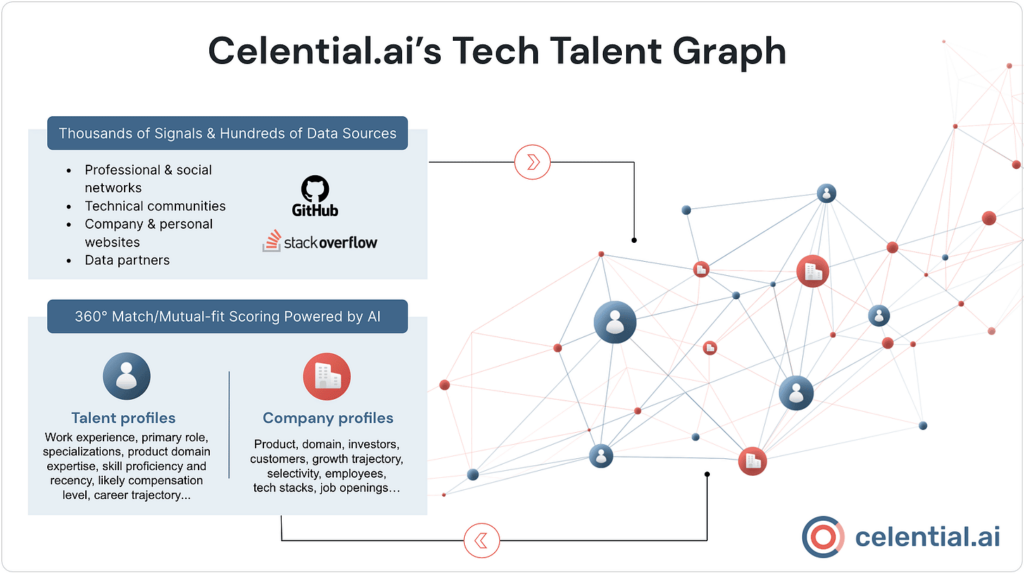
3. Recruitment marketing campaigns and data analytics
According to Salesforce, it takes 6-8 marketing touchpoints to create a viable sales lead.
The same concept holds true with hiring.
A passive candidate may need several follow-ups before they truly consider your offer. Marketing tools, such as marketing automation CRMs, can also automatically run campaigns for you through social media or text and nurture candidates or potential candidates with on-brand employer content.
Modern marketing management tools can also target potential candidates using criteria such as their location (“geo-targeting”). They also segment on candidates’ participation in your employee’s social media networks or whether they have previously visited your company website, directing ads to the candidates most likely to engage.
Our Virtual Recruiter also features an automated outreach program that requires zero effort from the talent acquisition team. Once a client confirms the candidates that the Virtual Recruiter has sourced for them (our approval rate is 70%+), our platform develops and deploys a multi-touch hyper-personalized campaign to attract their attention.
It even manages follow-up!
Our virtual recruiter leverages natural language processing to analyze a candidate’s reply. It identifies several common recruiting scenarios, determines the best response, and then creates it.
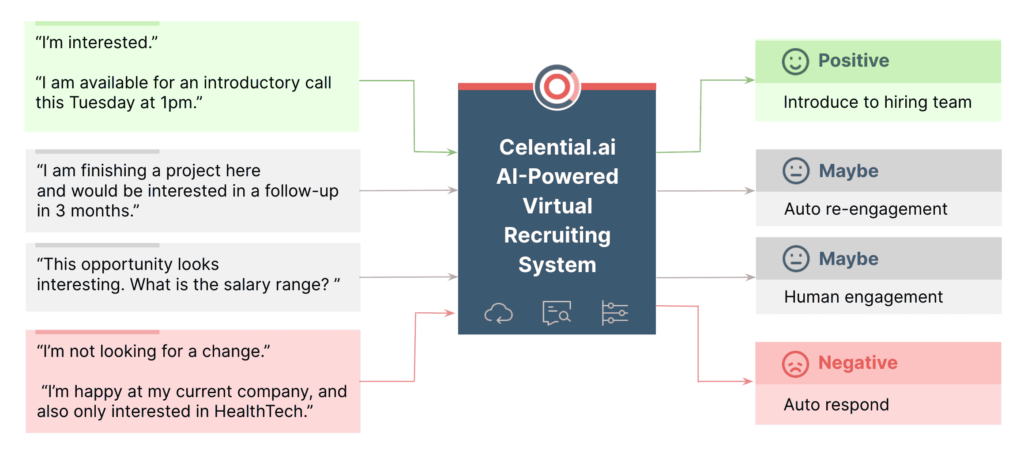
4. Candidate Outreach
Sourcing great candidates and messaging candidates isn’t easy, and that’s only half the battle — how do you convince them to reply?
While personalized messaging can significantly increase your reply rate, it is tough for busy founders and hiring teams to achieve at scale.
Tools and services such as Celential.ai that use automation to generate a personalized pitch, locate candidate emails, and follow up at optimal intervals on your behalf can save you lots of time, cost, and effort.
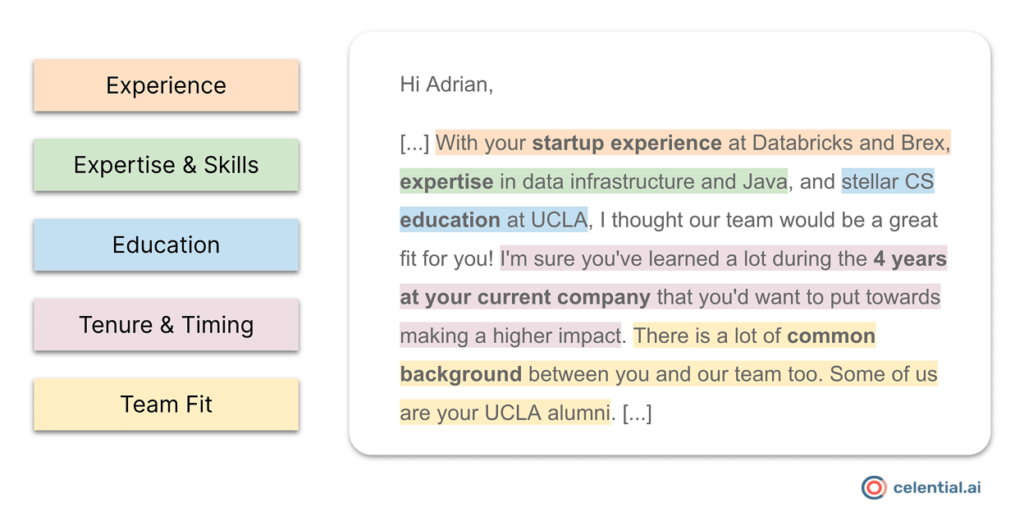
5. Resume screening
A recruiter spends 23 hours on average reading resumes for every hire they make.
However, recruiting teams can leverage AI to parse and rank the resumes closely matching your job description with automated resume analysis.
AI may not be as intelligent as a recruiter, but it can up your efficiency by eliminating unqualified resumes — which make up 3 of every 4 submissions.
These features are included in many popular ATS platforms — for example, Greenhouse or Lever.
6. Pre-employment assessment
Another way to cut down on all that time you spend reading resumes is to implement AI pre-employment screening using software such as Codility to rank candidates rapidly.
Depending on the role, you may wish to screen for technical skills, soft skills, cognitive ability, cultural fit, domain knowledge, language proficiency, or communication ability.

7. Automated interview scheduling
Finally, AI chatbots or automated interview scheduling software (HireVue, for example) can help busy recruiting teams take the pain out of pre-interview calendar Tetris.
Candidates often appreciate the ability to self-schedule and the efficiency of real-time communication and confirmation.
For excellent candidate experience, it’s helpful to program your chatbot with information and resources on the job description, team, compensation, interview structure, the expected timeline, and other frequently asked questions.
What are the advantages of Sourcing Automation?
In her keynote speech at EmTech 2017, roboticist Daniela Rus discussed a Harvard University study comparing the ability of expert physicians and cutting-edge AI to diagnose cancer.
Humans outperformed the machines. However, the best results actually were achieved when physicians teamed up with AI to solve the problem.
Similarly, sourcing automation doesn’t replace recruiters — but it can help them be a lot more productive and strategically effective.
In addition, intelligent sourcing allows you to target passive candidates more effectively.
Passive recruiting technology lets you find the best talent long before appearing on the active job market. For hard-to-fill roles in tech, sourcing passive candidates is critical — as only 17.3% of software developers are actively looking for a job.
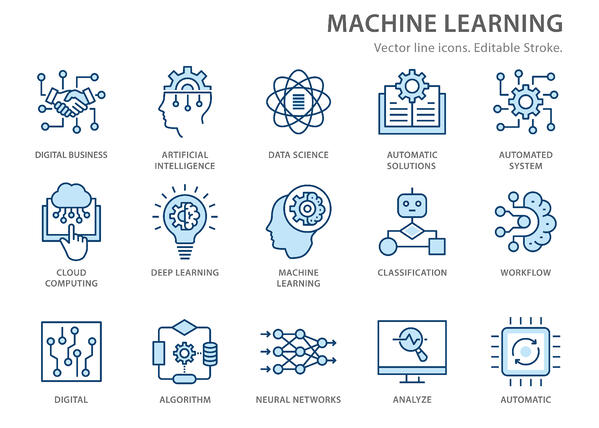
Here are the top reasons to use sourcing automation:
Save time and recruiting costs while boosting your candidate supply chain
According to Zippia, the typical corporate job opening receives 250 applicants. That’s a ton of resumes to read!
However, an automated AI system can instantaneously sort those resumes for you and put the most relevant candidates at the top of the pile.
Amid a talent crisis when recruiters are scarce, and resources are tight, delegating as much of the process as possible to technology — whether sourcing, reaching out to, screening, scheduling, or tracking candidates — will save considerable cost and support recruiting teams need.
Recruiters are usually “people people” who prefer to spend their time making meaningful connections with candidates. Free of repetitive administrative tasks, they can engage, nurture and close many more candidates than otherwise possible.
Keep candidate information and data organized
Applicant tracking was one of the first parts of the recruiting process to be automated, all the way back in the late 1990s.
It’s not hard to imagine why — an ATS can improve your workflow by tracking and storing the application, resume, interview documentation, and candidacy stage associated with each applicant.
By automatically tracking each candidate’s progress, you can quickly generate data regarding candidate demographics, bottlenecks in your hiring process, and more.
The more you automate, the easier it is to compare and make strategic, data-driven decisions on which tools and methods are actually producing results.
Candidate experience
Talent Board reported that nothing made candidates unhappier than an employer who failed to communicate, with a full 50% identifying this as their number one pain point.
Candidates want a speedy and seamless hiring process, as well as frequent and quick updates and scheduling. Recruiting automation can help you create a great candidate experience by giving candidates transparency into feedback and next steps.
Tim Sackett, president of HRU Technical Resources, an engineering and design staffing firm based in Lansing, Michigan, told SHRM of his success employing strategic interview reminder automation to increase a client’s show rate from 30% to 90%.
“Interviewees said they showed up because they felt the company really wanted them. They didn’t know they were communicating with a bot,” said Sackett.
Diversity Hiring
Traditional recruitment strategies which rely on standard professional networks and job-hunting sites may risk excluding diverse candidates. On the other hand, AI hiring solutions, can diversify your talent pool by identifying overlooked talent and offering proactive targeting of diverse candidates.

Sourcing automation can also improve your diversity hiring by allowing you to compare candidates more fairly and consistently, reducing unconscious bias in hiring processes.
However, it’s key to ensure that your algorithm is well designed to be inclusive and free of bias, as a poorly constructed AI system can replicate the preferences or characteristics of its designers.
The pitfalls of relying too much on automation
Intelligent sourcing doesn’t replace a recruiter. Though automation technology grows more advanced and valuable every day, overreliance can have significant downsides.
Lack of personal connection
Candidates want to feel valued, and unique — they don’t want to feel like interchangeable widgets on the factory line.
Automation that is not performed with care (such as in outreach messages, scheduling chatboxes, or employment assessments) can feel annoying, impersonal, and robotic — exactly the opposite effect as desired.

The goal is to eliminate only the manual and repetitive parts of the hiring process preventing recruiting teams from personally engaging candidates with thoughtful, human-centered interactions.
Lack of accuracy
In 2022, computers haven’t mastered the art of nuance yet and find it challenging to handle formatting, word choice variation, or other aspects of job applications or resumes that may be outside the expected, standard programmed model.
While a human may be able to quickly identify skills that may be transferable or gauge tone and soft skills from writing, computers may miss out on candidates that don’t closely resemble the model but who would be a perfect fit for your business.
Keyword hacking
There are many ways in which candidates can optimize their resumes for more points in your automated hiring system. The candidate who has added more phrases from your JD into their resume is not necessarily a better fit than one who has not.
In extreme cases, some candidates have turned to hacks such as adding keywords or even the whole JD to their resume in white-colored or very small text — able to be picked up by the tool, but not the human eye.
Wrapping Up
Working with Celential.ai can take the pain out of passive recruiting. We take care of all the automation for you — and you’ll receive qualified, warm talent ready for interviews in 3 business days.
Via our vertical talent graph of 20M+ engineering and sales talent across North America, our solution preserves and augments the human element of recruiting while automating the repetitive and time-consuming part.
No learning curve or tool to learn. Just results!
Table of Contents






























